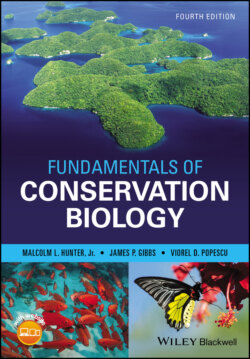Читать книгу Fundamentals of Conservation Biology - Malcolm L. Hunter Jr. - Страница 89
CASE STUDY 4.1 Mangrove Swamps
ОглавлениеTropical shores are not all white‐sand beaches lined by coconut palms. In many places the land–sea transition is marked by dense stands of trees and shrubs that form mangrove swamps or mangal (Fig. 4.12). The seaward edge of a mangrove swamp is usually sharply delineated, but moving inland it often grades into other types of swamps as the elevation rises and the water becomes less saline. This gradation is one reason why the term “mangrove” is rather ambiguous. “Mangrove” is a quasi‐taxonomic term that can be used for at least 70 species of woody plants from 11 families that inhabit tropical intertidal environments (Wang et al. 2003). Depending on the range of salinities you choose to include, many more species could be added. Of course, on a global scale 70 species is not very many and in any given mangrove swamp only one or a few species of mangrove may occur.
Figure 4.12 Mangroves are marine wetlands that occur along many tropical coastlines.
(William Warby/Flickr/CC BY 2.0)
Despite modest levels of plant species diversity, mangrove swamps are important and interesting ecosystems (Kathiresan and Bingham 2001 ; Nagelkerken et al. 2008; Feller et al. 2010). First, they are extremely productive, capturing sunlight and collecting nutrients imported by the tides, and exporting huge amounts of organic matter to the adjacent aquatic ecosystems where they support aquatic food webs and economically valuable fisheries. For some fish species, mangrove swamps are often called nurseries because they provide food and cover for young individuals (Paillon et al. 2014). They also provide a sort of cover for shoreline human communities by creating a buffer against ocean storms and tsunamis. Conversely, they buffer coral‐reef and sea‐grass ecosystems from siltation stemming from inland erosion. Mangrove swamps also provide resources – timber and fuelwood – that sometimes, unfortunately, lead to their overexploitation. Worse than the threat of excessive timber harvesting is the wholesale destruction of mangrove swamps to make room for aquaculture (notably for shrimp production ponds), agriculture, and coastal development (ranging from garbage dumps to high‐rise hotels). Because they occupy a narrow band between the land and the sea, mangrove swamps have never occupied a large total area, and this makes it doubly tragic that so many have been lost. Worldwide, a substantial portion of mangroves have been destroyed, probably leaving far less than 200,000 km2 (Sandilyan and Kathiresan 2012 ; Webb and Friess 2014). This seems particularly short‐sighted given economic studies like one from India that estimated local income of $753/ha/year from natural products tied to mangroves versus $438 from mangroves converted to rice paddies (Chauhan et al. 2017). The mangroves’ value soared to over $5000/ha/year if you add more speculative values such as protection from storms and carbon sequestration.
